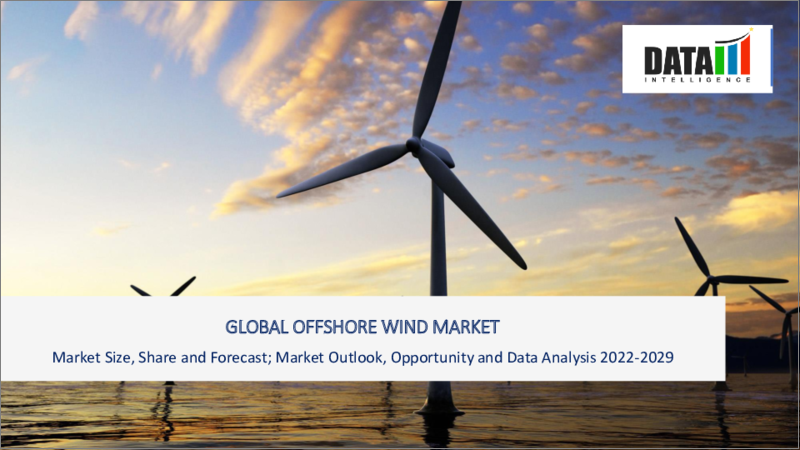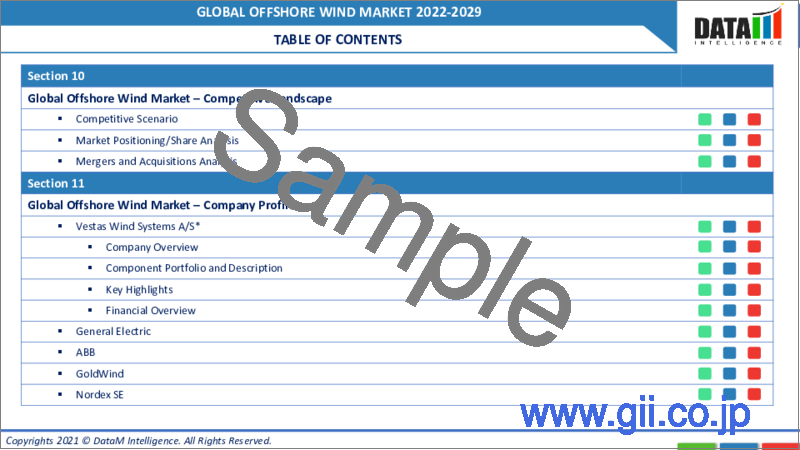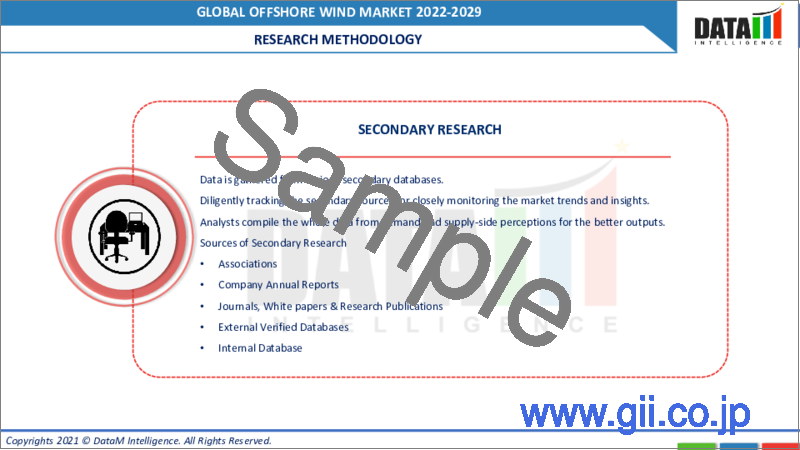|
|
市場調査レポート
商品コード
1082849
洋上風力の世界市場(2022年~2029年)Global Offshore Wind Market - 2022-2029 |
||||||
|
● お客様のご希望に応じて、既存データの加工や未掲載情報(例:国別セグメント)の追加などの対応が可能です。 詳細はお問い合わせください。 |
|||||||
| 洋上風力の世界市場(2022年~2029年) |
|
出版日: 2022年06月03日
発行: DataM Intelligence
ページ情報: 英文 220 Pages
納期: 約2営業日
|
- 全表示
- 概要
- 目次
当レポートでは、世界の洋上風力市場について調査分析し、市場動向、市場促進・抑制要因、COVID-19の影響、業界分析、セグメント別・地域別の市場分析、競合情勢、企業プロファイルなどの情報を提供しています。
目次
第1章 世界の洋上風力市場の調査手法と範囲
第2章 世界の洋上風力市場:市場の定義と概要
第3章 世界の洋上風力市場:エグゼクティブサマリー
- コンポーネント別の市場内訳
- 場所別の市場内訳
- 地域別の市場内訳
第4章 世界の洋上風力市場:市場力学
- 市場に影響を与える要因
- 促進要因
- 抑制要因
- 市場機会
- 影響分析
第5章 世界の洋上風力市場:業界分析
- ポーターのファイブフォース分析
- サプライチェーン分析
- 価格分析
- 規制分析
第6章 世界の洋上風力市場:COVID-19分析
- 市場へのCOVID-19の影響分析
- COVID-19前の市場シナリオ
- 現在のCOVID-19の市場シナリオ
- COVID-19後、または将来のシナリオ
- COVID-19禍における価格力学
- 需要と供給のスペクトル
- パンデミック時の市場に関連する政府の取り組み
- メーカーの戦略的取り組み
- 結論
第7章 世界の洋上風力市場:コンポーネント別
- イントロダクション
- 市場規模分析・前年比成長分析(%):コンポーネント別
- 市場魅力指数:コンポーネント別
- タービン
- イントロダクション
- 市場規模分析・前年比成長分析(%)
- 電気インフラ
- 下部構造
- その他
第8章 世界の洋上風力市場:場所別
- イントロダクション
- 市場規模分析・前年比成長分析(%):場所別
- 市場魅力指数:場所別
- 浅海
- イントロダクション
- 市場規模分析・前年比成長分析(%)
- 転移水域
- 深海
第9章 世界の洋上風力市場:地域別
- イントロダクション
- 市場規模分析・前年比成長分析(%):地域別
- 市場魅力指数:地域別
- 北米
- 欧州
- 南米
- アジア太平洋
- 中東・アフリカ
第10章 世界の洋上風力市場:競合情勢
- 競合シナリオ
- 市場ポジショニング/シェア分析
- 合併と買収の分析
第11章 世界の洋上風力市場:企業プロファイル
- Vestas Wind Systems A/S
- 企業概要
- 製品ポートフォリオ・説明
- 主要ハイライト
- 財務概要
- General Electric
- ABB
- GoldWind
- Nordex SE
- EEW Group
- Nexans
- Doosan Heavy Industries & Construction.
- Siemens Gamesa Renewable Energy, S.A.
- Shanghai Electric Power Generation Equipment Co., Ltd.
第12章 世界の洋上風力市場:重要考察
第13章 世界の洋上風力市場:DataM
Market Overview
The global offshore wind market size was worth US$ XX million in 2021 and is estimated to reach US$ XX million by 2029, growing at a CAGR of XX% during the forecast period (2022-2029).
Wind energy is renewable energy, where wind turbines generate electricity. The generator, nacelle, rotor blades and tower are the key components of a wind turbine. In a wind turbine, the aerodynamic force of the rotor blades acts similar to an airplane wing to convert wind energy into electricity.
One side's air pressure drops when the wind blows across the blade. The air pressure difference between the blade's two sides causes lift and drag. The rotor spins because the lift force is greater than the drag force. The rotor is connected directly with the generator in case of a direct drive turbine. An indirect connection is also made through a shaft and gearbox, which speeds up the blade rotation. An indirect drive turbine allows the generator to be physically smaller. Power is generated by converting aerodynamic force to generator rotation. Wind turbines are horizontal or vertical, depending on the required power generation configuration.
Offshore wind energy is relatively more advantageous than onshore wind turbines since strong wind is produced on the high seas. Therefore, wind turbines can reach higher speeds for prolonged periods without land-based barriers. The electricity generated through the offshore wind farm is transferred through the wind turbine towers to a converter that converts direct current to alternating current. The alternating current is then sent to a shore-based transmission and distribution system. With rising global investment in renewable energy, the development of offshore wind farms is expected to greatly increase in the coming years.
Market Dynamics
The demand for offshore wind is mainly driven by the increasing global investment in renewable energy. The high capital costs and logistical issues are key factors in limiting the growth of this market.
Increasing global investment in renewable energy
Decreasing the costs of renewable energy, a growing need to reduce carbon emissions and rising energy consumption in developing and underdeveloped countries create a rising demand for renewable energy globally. To meet the COP26 Glasgow Agreement's aims, the share of renewables in annual global energy generation must climb from 25% to 86 percent by 2050, according to the International Renewable Energy Agency (IRENA).
To achieve these goals, the world will need to invest US$ 2.5 trillion in renewable energy by 2050, up from the previous estimate of US$ 1.2 trillion. Due to the growing importance of combating man-made climate change, there will be a noticeable shift away from fossil fuels and renewable energy sources. IRENA estimates that US$ 3.3 trillion will be spent on new power generation assets between 2019 and 2050, with 15,145 GW of carbon-free capacity likely to be built in that period. If current projections hold, wind and solar could account for 50% of the global electricity generation by 2050.
Several government programs are in place to aid the transition to greener energy. Many multinational corporations are taking steps to reduce their carbon footprint to contribute to a greener world and long-term sustainability. Major energy companies are pledging to significantly increase the share of renewable energy in their portfolios. The companies are making substantial investments in green energy to meet these goals. U.S. Department of Energy's Wind Energy Technologies Office (WETO) provides funding of up to US$ 12 billion for the development and deployment of new offshore wind projects. The European Commission (EC) is investing nearly US$ 800 billion through 2050 to increase offshore wind generation capacity from 12GW currently to more than 300GW by 2050. The increasing global investment in renewable energy is a key driver for the growth of the global offshore wind market.
High capital costs and logistical issues associated with offshore wind
Offshore wind energy is one of the most promising and environmentally benign energy generation technologies available. Though it has a high-capacity factor compared to similar technologies like solar and onshore wind, its high capital cost prevents it from being implemented. Offshore wind turbines are prone to erosion since they have operated in severe marine environments for decades. Even the most favorable characteristics, such as strong wind speeds, can disadvantage offshore wind turbines. Whenever the wind speed exceeds 25 m/s, the turbines, for example, tend to shut down.
The size of offshore wind farms has become larger, so construction, transportation, installation and operation obstacles have grown more complex. Logistical challenges are more difficult to overcome in offshore wind farms. Wind farms are typically placed far from the coast and are difficult to reach, particularly in poor weather. As a result, even the tiniest technical fault could be difficult and costly to resolve.
Other difficult aspects of offshore wind deployment include resource characterization, grid connections and operation and transmission infrastructure development, which are significantly easier in other technologies like solar and onshore wind. As a result, the growth of the global offshore wind market is constrained by high capital expenditures and challenges related to operations, maintenance, transportation and logistics.
COVID-19 impact analysis
The global offshore wind market experienced severe impacts on production and deployment in 2020 due to the COVID-19 pandemic. Lockdowns and other government-imposed movement restrictions halted construction activities, affecting the construction of new wind turbine plants. Only minor and major maintenance activities were taking place during the initial phase of the pandemic.
Wind turbine components are manufactured by a wide range of subcontractors and assembled in many different countries globally. Therefore, the supply chain is fragile and highly vulnerable to external shocks. The global pandemic has caused massive shocks to the global supply chain and logistics, thereby affecting the production of wind turbines. The production is not expected to recover to pre-pandemic levels before the end of 2021.
The impact of the COVID-19 pandemic has been relatively severe for the offshore wind market in the short term. Major cuts to capital expenditures and new investments in response to the pandemic halted expansion and new projects. The pandemic will not majorly impact the long-term growth of the global offshore wind market since governments are prioritizing investment in renewable energy to stimulate their economy after the economic downturn brought on by the pandemic. Investment in renewable wind energy is likely to increase even further given the lowering of technological costs and increasing commitment to renewable energy. The demand for offshore wind turbine plants remains strong and is expected to grow gradually in the coming years.
Segment Analysis
The global offshore wind market is segmented into components, location and region. The offshore wind market is further segmented into turbines, electrical infrastructure, substructures and others based on components.
The turbine leads in this segmentation since it is the most important part of the offshore wind energy station. The propeller blades of the turbine revolve around a rotor due to wind, which spins coiling in a generator that induces an electric current which is transferred through a converter for transmission and distribution.
Geographical Analysis
Europe is leading in the global offshore wind market. The region accounts for the largest market share, primarily due to major investments in renewable green energy and major offshore wind projects currently under construction in the region. The geography of Europe makes it favorable for offshore energy generation. The shallow water found along the entire northern coastline of Europe with favorable high winds from the North Sea makes it ideal for offshore wind energy generation.
The European Commission (EC) is investing nearly US$ 800 billion through 2050 to increase offshore wind generation capacity from 12GW currently to more than 300GW by 2050. Some of the largest offshore wind projects are currently under construction in Europe, particularly in Denmark, Norway, UK and Sweden. The Hornsea Project One in UK is currently the largest offshore wind project in operation, with a capacity of more than 1200 MW. More than 50 offshore wind projects are in operation in the Baltic Sea and the North Sea. Some of the largest offshore wind projects are currently under construction in Europe, particularly in Denmark, Norway, UK and Sweden. The European region is expected to retain the largest share in the global offshore wind market in the coming years.
Competitive Landscape
The global offshore wind market is competitive due to the availability of a wide variety of wind turbine systems that cater to different types of renewable power generation requirements. Some of the major players contributing to the growth in the segment are Vestas Wind Systems A/S, General Electric, ABB, GoldWind, Nordex SE, EEW Group, Nexans, Doosan Heavy Industries & Construction, Siemens Gamesa Renewable Energy, S.A. and Shanghai Electric Power Generation Equipment Co., Ltd. The significant players adopt several growth strategies such as new product launches, joint ventures and collaborations, contributing to global growth in the industry.
Vestas Wind Systems A/S
Overview: Vestas Wind Systems A/S is an engineering company that primarily engages in the research, design, manufacturing, selling and servicing of wind turbine systems. The company employs 25,000 people and operates manufacturing plants in Denmark, Germany, the Netherlands, Taiwan, India, Italy, Romania, UK, Spain, Sweden, Norway, Australia, China, Brazil, Poland and U.S. Vestas Wind System's products have been installed in more than 80 countries globally. Vestas Wind Systems A/S was founded by Danish engineer Peder Hansen in 1945 and is headquartered in Aarhus, Denmark.
Product Portfolio
4MW Platform is the company's flagship wind turbine product for onshore and offshore energy generation applications. The rotor diameter is customizable from 105 to 155 meters. The construction is optimized for performance in low wind and calm weather conditions.
Key Developments:
In March 2022, Vestas Wind Systems A/S received a contract from a consortium of Marhult Vind AB, Octopus Renewables and OX2 to develop a 32 MW offshore wind farm for Uppvidinge municipality in Vaxjo, Sweden. The order includes the construction and maintenance of seven 4.5 MW turbines. Construction of the project is expected to start in early 2023.
Why Purchase the Report?
Visualize the composition of the offshore wind market segmentation by the component, location and region, highlighting the critical commercial assets and players.
Identify commercial opportunities in the offshore wind market by analyzing trends and co-development deals.
Excel data sheet with thousands of global offshore wind market-level 4/5 segmentation data points.
PDF report with the most relevant analysis cogently put together after exhaustive qualitative interviews and in-depth market study.
Product mapping in excel for the critical product of all major market players
The global offshore wind market report would provide access to an approx.: 51 market data tables, 58 figures and 220 pages.
Target Audience 2022
Offshore wind manufacturers
Food and beverage industries
Medical and pharmaceutical industries
Automotive component manufacturers
Industry Investors/Investment Bankers
Education & Research Institutes
Research Professionals
Table of Contents
1. Global Offshore Wind Market Methodology and Scope
- 1.1. Research Methodology
- 1.2. Research Objective and Scope of the Report
2. Global Offshore Wind Market - Market Definition and Overview
3. Global Offshore Wind Market - Executive Summary
- 3.1. Market Snippet by Component
- 3.2. Market Snippet by Location
- 3.3. Market Snippet by Region
4. Global Offshore Wind Market-Market Dynamics
- 4.1. Market Impacting Factors
- 4.1.1. Drivers
- 4.1.1.1. Increasing global investment in renewable energy
- 4.1.1.2. XX
- 4.1.2. Restraints
- 4.1.2.1. High capital costs and logistical issues associated with offshore wind energy
- 4.1.2.2. XX
- 4.1.3. Opportunity
- 4.1.3.1. XX
- 4.1.4. Impact Analysis
- 4.1.1. Drivers
5. Global Offshore Wind Market - Industry Analysis
- 5.1. Porter's Five Forces Analysis
- 5.2. Supply Chain Analysis
- 5.3. Pricing Analysis
- 5.4. Regulatory Analysis
6. Global Offshore Wind Market - COVID-19 Analysis
- 6.1. Analysis of COVID-19 on the Market
- 6.1.1. Before COVID-19 Market Scenario
- 6.1.2. Present COVID-19 Market Scenario
- 6.1.3. After COVID-19 or Future Scenario
- 6.2. Pricing Dynamics Amid COVID-19
- 6.3. Demand-Supply Spectrum
- 6.4. Government Initiatives Related to the Market During Pandemic
- 6.5. Manufacturers Strategic Initiatives
- 6.6. Conclusion
7. Global Offshore Wind Market - By Component
- 7.1. Introduction
- 7.1.1. Market Size Analysis and Y-o-Y Growth Analysis (%), By Component
- 7.1.2. Market Attractiveness Index, By Component
- 7.2. Turbines
- 7.2.1. Introduction
- 7.2.2. Market Size Analysis and Y-o-Y Growth Analysis (%)
- 7.3. Electrical Infrastructure
- 7.4. Substructure
- 7.5. Others
8. Global Offshore Wind Market - By Location
- 8.1. Introduction
- 8.1.1. Market Size Analysis and Y-o-Y Growth Analysis (%), By Location
- 8.1.2. Market Attractiveness Index, By Location
- 8.2. Shallow Water
- 8.2.1. Introduction
- 8.2.2. Market Size Analysis and Y-o-Y Growth Analysis (%)
- 8.3. Transitional Water
- 8.4. Deep Water
9. Global Offshore Wind Market - By Region
- 9.1. Introduction
- 9.1.1. Market Size Analysis and Y-o-Y Growth Analysis (%), By Region
- 9.1.2. Market Attractiveness Index, By Region
- 9.2. North America
- 9.2.1. Introduction
- 9.2.2. Key Region-Specific Dynamics
- 9.2.3. Market Size Analysis and Y-o-Y Growth Analysis (%), By Component
- 9.2.4. Market Size Analysis and Y-o-Y Growth Analysis (%), By Location
- 9.2.5. Market Size Analysis and Y-o-Y Growth Analysis (%), By Country
- 9.2.5.1. U.S.
- 9.2.5.2. Canada
- 9.2.5.3. Mexico
- 9.3. Europe
- 9.3.1. Introduction
- 9.3.2. Key Region-Specific Dynamics
- 9.3.3. Market Size Analysis and Y-o-Y Growth Analysis (%), By Component
- 9.3.4. Market Size Analysis and Y-o-Y Growth Analysis (%), By Location
- 9.3.5. Market Size Analysis and Y-o-Y Growth Analysis (%), By Country
- 9.3.5.1. Germany
- 9.3.5.2. UK
- 9.3.5.3. France
- 9.3.5.4. Italy
- 9.3.5.5. Spain
- 9.3.5.6. Rest of Europe
- 9.4. South America
- 9.4.1. Introduction
- 9.4.2. Key Region-Specific Dynamics
- 9.4.3. Market Size Analysis and Y-o-Y Growth Analysis (%), By Component
- 9.4.4. Market Size Analysis and Y-o-Y Growth Analysis (%), By Location
- 9.4.5. Market Size Analysis and Y-o-Y Growth Analysis (%), By Country
- 9.4.5.1. Brazil
- 9.4.5.2. Argentina
- 9.4.5.3. Rest of South America
- 9.5. Asia-Pacific
- 9.5.1. Introduction
- 9.5.2. Key Region-Specific Dynamics
- 9.5.3. Market Size Analysis and Y-o-Y Growth Analysis (%), By Component
- 9.5.4. Market Size Analysis and Y-o-Y Growth Analysis (%), By Location
- 9.5.5. Market Size Analysis and Y-o-Y Growth Analysis (%), By Country
- 9.5.5.1. China
- 9.5.5.2. India
- 9.5.5.3. Japan
- 9.5.5.4. South Korea
- 9.5.5.5. Rest of Asia-Pacific
- 9.6. Middle East and Africa
- 9.6.1. Introduction
- 9.6.2. Key Region-Specific Dynamics
- 9.6.3. Market Size Analysis and Y-o-Y Growth Analysis (%), By Component
- 9.6.4. Market Size Analysis and Y-o-Y Growth Analysis (%), By Location
10. Global Offshore Wind Market - Competitive Landscape
- 10.1. Competitive Scenario
- 10.2. Market Positioning/Share Analysis
- 10.3. Mergers and Acquisitions Analysis
11. Global Offshore Wind Market- Company Profiles
- 11.1. Vestas Wind Systems A/S
- 11.1.1. Company Overview
- 11.1.2. Product Portfolio and Description
- 11.1.3. Key Highlights
- 11.1.4. Financial Overview
- 11.2. General Electric
- 11.3. ABB
- 11.4. GoldWind
- 11.5. Nordex SE
- 11.6. EEW Group
- 11.7. Nexans
- 11.8. Doosan Heavy Industries & Construction.
- 11.9. Siemens Gamesa Renewable Energy, S.A.
- 11.10. Shanghai Electric Power Generation Equipment Co., Ltd.
LIST NOT EXHAUSTIVE
12. Global Offshore Wind Market - Premium Insights
13. Global Offshore Wind Market - DataM
- 13.1. Appendix
- 13.2. About Us and Services
- 13.3. Contact Us




